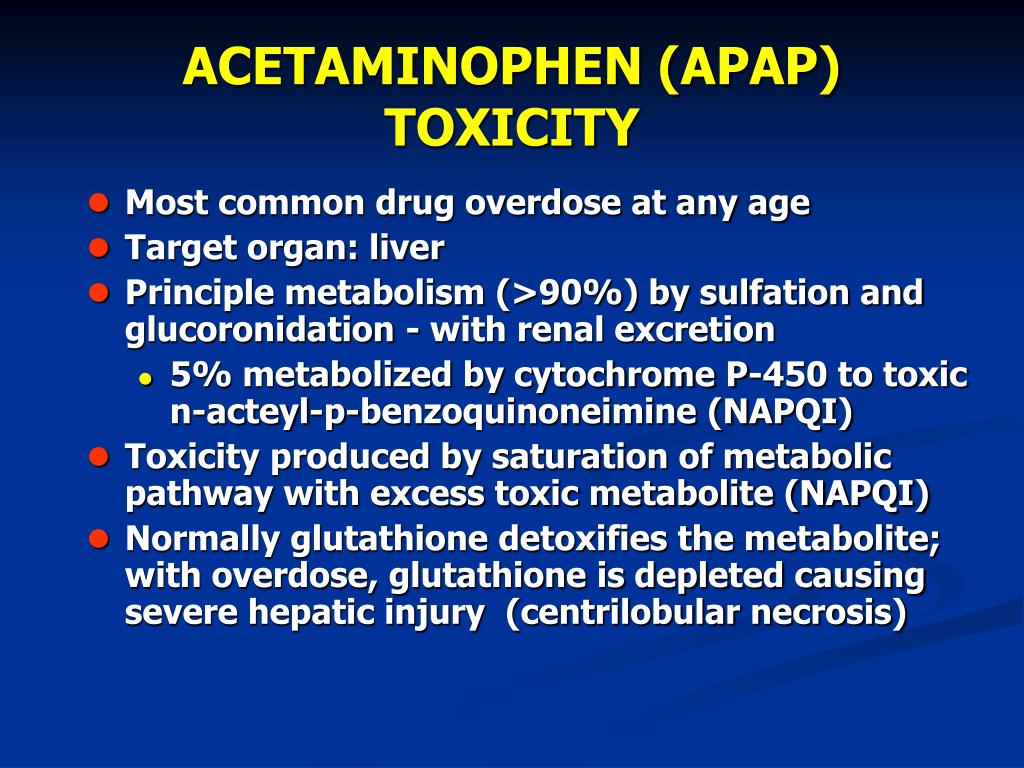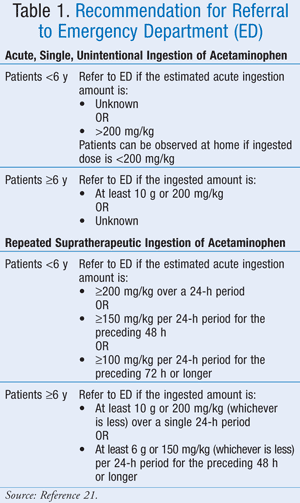


Either there is full resolution of hepatotoxicity or fulminant liver failure progresses to multiorgan failure and death.
 Stage 4 (>96 hours): Survival or death. Liver function tests peak, and clinical signs and symptoms of liver failure are evident, including jaundice, vomiting and gastrointestinal pain, coagulopathy, encephalopathy, metabolic acidosis, and possibly acute renal failure and/or pancreatitis. Stage 3 (72–96 hours): Hepatic failure with encephalopathy. If injury is severe, then coagulopathy studies (PT, PTT, INR) may increase. Acetaminophen overdose occurs when someone accidentally or intentionally takes more than the normal or recommended amount of this medication. AST and ALT begin to rise, and possibly bilirubin. Medications for Acetaminophen Overdose Other names: Acetaminophen Toxicity Acetaminophen (Tylenol) is a pain medicine. Patients may begin to develop RUQ pain, although sometimes they are clinically asymptomatic. Stage 2 (24–72 hours): Hepatic injury (hepatotoxicity). The vague, nonspecific symptoms of this stage might include nausea and vomiting, diffuse abdominal pain, and general malaise. Stage 1 (0–24 hours): Preclinical toxic effects with minimal signs and symptoms, possibly asymptomatic, and often normal liver function tests. It is most often administered with a nebulizer that breaks up the solution into aerosol particles that can be inhaled into the lungs. Mucomyst, on the other hand, is a mucolytic agent that is available as a prescription medication. Guaifenesin is an expectorant that helps thin and loosens mucus so that it can be coughed up and removed from the lungs. Mucinex is the brand name for the over-the-counter medication guaifenesin. What is the Difference between Mucinex and Mucomyst? However, there may be generic versions of acetylcysteine available if they have been approved by the FDA. Yes, the brand name Mucomyst has been discontinued in the United States. However, when administered with a nebulizer, Mucomyst is effective in helping break up mucus so that it becomes easier to cough up for removal. No, Mucomyst is available as a solution for nebulization and must be used with a special aerosol-generating device.
Stage 4 (>96 hours): Survival or death. Liver function tests peak, and clinical signs and symptoms of liver failure are evident, including jaundice, vomiting and gastrointestinal pain, coagulopathy, encephalopathy, metabolic acidosis, and possibly acute renal failure and/or pancreatitis. Stage 3 (72–96 hours): Hepatic failure with encephalopathy. If injury is severe, then coagulopathy studies (PT, PTT, INR) may increase. Acetaminophen overdose occurs when someone accidentally or intentionally takes more than the normal or recommended amount of this medication. AST and ALT begin to rise, and possibly bilirubin. Medications for Acetaminophen Overdose Other names: Acetaminophen Toxicity Acetaminophen (Tylenol) is a pain medicine. Patients may begin to develop RUQ pain, although sometimes they are clinically asymptomatic. Stage 2 (24–72 hours): Hepatic injury (hepatotoxicity). The vague, nonspecific symptoms of this stage might include nausea and vomiting, diffuse abdominal pain, and general malaise. Stage 1 (0–24 hours): Preclinical toxic effects with minimal signs and symptoms, possibly asymptomatic, and often normal liver function tests. It is most often administered with a nebulizer that breaks up the solution into aerosol particles that can be inhaled into the lungs. Mucomyst, on the other hand, is a mucolytic agent that is available as a prescription medication. Guaifenesin is an expectorant that helps thin and loosens mucus so that it can be coughed up and removed from the lungs. Mucinex is the brand name for the over-the-counter medication guaifenesin. What is the Difference between Mucinex and Mucomyst? However, there may be generic versions of acetylcysteine available if they have been approved by the FDA. Yes, the brand name Mucomyst has been discontinued in the United States. However, when administered with a nebulizer, Mucomyst is effective in helping break up mucus so that it becomes easier to cough up for removal. No, Mucomyst is available as a solution for nebulization and must be used with a special aerosol-generating device. 
Its use requires medical supervision and is often administered via nebulization by a trained respiratory therapist. Mucomyst is a prescription medication, so it cannot be purchased over-the-counter from a retail store.








 0 kommentar(er)
0 kommentar(er)
